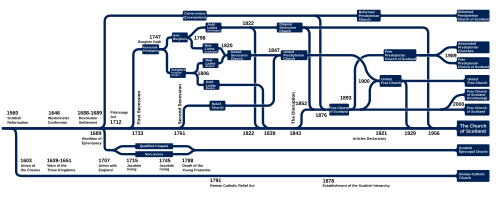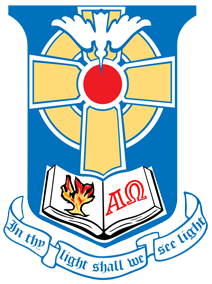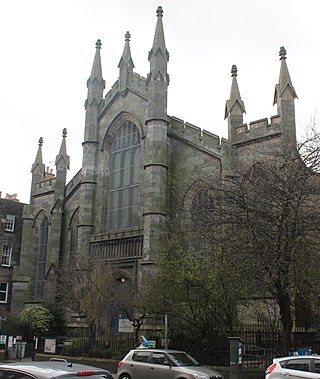This article needs additional citations for verification .(August 2020) |

The Anti-Burghers were opponents of the Burgher Oath on theological grounds. [1]
This article needs additional citations for verification .(August 2020) |

The Anti-Burghers were opponents of the Burgher Oath on theological grounds. [1]
In 1733 the First Secession from the Church of Scotland resulted in the creation of the "Associate Presbytery". This church split in 1747 over the issue of the Burgher Oath, which required holders of public offices to affirm approval of the religion "presently professed in this kingdom". The issue was civil compulsion in religious affairs, a forerunner of later arguments over the separation of church and state. Opponents of the Burgher Oath on theological grounds became known as the Anti-Burghers—showing a distinctive independence of conviction and an unwillingness to compromise over sincerely held beliefs. The Burgher and Anti-Burgher factions thus formed rival, independent synods—the General Associate Synod (Antiburghers) and the Associate Synod (Burghers)
Eventually both the Burghers and Anti-Burghers had further splits, the Burghers in 1798 and the Anti-Burghers in 1806. Both factions formed their own, separate "Auld Licht" (old light) and "New Licht" factions. The more Calvinistic "Auld Lichts" held to the obligations of the Solemn League and Covenant, the "New Lichts" were more theologically liberal—a notable and continuing influence in the post-1847 United Presbyterian Church of Scotland.
In 1820, the majority of the New Licht Anti-Burghers united with the New Licht Burghers as the United Secession Church. "A conservative 'clique' led by Professor George Paxton and Dr Stevenson [George Stevenson of Ayr] forming the 'Synod of Protesters' in May 1821." [2] The United Secession Church in turn united with the Relief Church in 1847 to create the United Presbyterian Church of Scotland. The United Presbyterian Church united with most of the Free Church of Scotland in 1900 to create the United Free Church of Scotland, most of whom ultimately reunited with the Church of Scotland in 1929.
The Anti-Burgher Auld Lichts formed the Constitutional Associate Presbytery. [3] The four ministers who constituted it were James Aitken of Kirriemuir, Archibald Bruce, James Hog of Kelso and Thomas M'Crie the elder. The "Synod of Protesters" including George Paxton (minister) joined it in 1827 and it became the Original Secession Church. In 1842 this body united with the portion of the Old Light Burgher Synod which had not joined the Church of Scotland in 1839, to form the United Original Secession Church. This church split in 1852, one party joining in the Free Church of Scotland, the others finally reuniting with the Church of Scotland in 1956.
The careers of the father and son Thomas M'Crie the Elder and Thomas M'Crie the Younger illustrate the history of various Scottish denominations.
1. The father was ordained in 1796 as a minister of the Anti-Burgher Secession Synod.
2. The father was one of the 'Old Lights' who left the Anti-Burgher Secession Synod in 1806 to form the "Constitutional Associate Presbytery".
3, The son was ordained in 1821 as a minister of the 'Old Light' Anti-Burgher "Constitutional Associate Presbytery". The father and the son served together as ministers of that Presbytery for the remainder of its existence.
4. In 1827 the 'Old Light' Anti-Burgher Constitutional Associate Presbytery united with the 'Synod of Protesters' (which had left the New Licht' Anti-Burgher Synod in 1820-1) to form the 'Associate Synod of Original Seceders', also known as the Original Secession Church. The father and the son served together as ministers of this Church until the father's death in 1835, after which the son continued to serve as such for the remainder of the church's existence.
5. In 1842 the Original Secession Church united with the portion of the Old Light Burghers which had refused to merge with the Church of Scotland, to form the 'United Original Secession Church', and the son became a member of that church.
6. In 1852 some of the members of the United Original Secession Church, including the son, joined the Free Church of Scotland formed by the Disruption of 1843.
5. In 1856 the son became a professor in the Theological College of English Presbyterian Church.
6. The son resigned from that post in 1866.
(Other than the theological professors listed below)
1. Alexander Moncrieff (one of the 1733 seceders) (1747–1761)
2. William Moncrieff (1761–1786)
3. Archibald Bruce (1786–1806)
1. George Paxton (1807–1820)
1. Archibald Bruce (1806–1816)
2. George Paxton (Original Secession Church – 1827–1836)
3. Thomas M'Crie the Younger (Original Secession Church – 1836–1842) ( United Original Secession Church – 1842–1852)

Adam Gib was a Scottish religious leader, head of the Antiburgher section of the Scottish Secession Church. He reportedly wrote his first covenant with God in the blood of his own veins. Gib was born in the parish of Muckhart, in southern Perthshire on 15 April 1714.

The Associate Reformed Presbyterian Church (ARPC) is a theologically conservative denomination in North America. The ARPC was formed by the merger of the Associate Presbytery (seceder) with the Reformed Presbytery (covenanter) in 1782. It is one of the oldest conservative denominations in the United States.
The United Secession Church was a Scottish Presbyterian denomination which existed between 1820 and 1847.

Thomas M'Crie was a Scottish biographer and ecclesiastical historian, writer, and preacher born in the town of Duns, and educated at the University of Edinburgh. He became the leading minister of the Original Secession Church. His work: "Life of Knox" (1813) was a means of vindicating the Scottish reformer John Knox who was a unpopular figure at the time. It was followed by a "Life of Andrew Melville" (1819). Melville was Knox's successor as the leader of the Reformers in Scotland. M'Crie also published histories of the Reformation in Italy and Spain. He received an honorary degree of D.D. in 1813, the first Secession minister to receive such an award.

Thomas M'Crie was a Presbyterian minister and church historian. He was a Scottish Secession minister who joined the Free Church of Scotland and served as the Moderator of the General Assembly to that church 1856/57.

The First Secession was an exodus of ministers and members from the Church of Scotland in 1733. Those who took part formed the Associate Presbytery and later the United Secession Church. They were often referred to as Seceders.

The Reformed Presbyterian Church of Scotland is a small, Scottish, Presbyterian church denomination. Theologically they are similar to many other Presbyterian denominations in that their office-bearers subscribe to the Westminster Confession of Faith. In practice, they are more theologically conservative than most Scottish Presbyterians and maintain a very traditional form of worship. In 1690, after the Revolution, Alexander Shields joined the Church of Scotland, and was received along with two other ministers. These had previously ministered to a group of dissenters of the United Societies at a time when unlicensed meetings were outlawed. Unlike these ministers, some Presbyterians did not join the reconstituted Church of Scotland. From these roots the Reformed Presbyterian Church of Scotland was formed. It grew until there were congregations in several countries. In 1876 the majority of Reformed Presbyterians, or RPs, joined the Free Church of Scotland, and thus the present-day church, which remained outside this union, is a continuing church. There are currently Scottish RP congregations in Airdrie, Stranraer, Stornoway, Glasgow, and North Edinburgh. Internationally they form part of the Reformed Presbyterian Communion.
Robert Balmer (1787–1844), was successively a minister of the Burgher Seceder, New Licht Burgher Seceder and United Associate Synod of the Secession Churches in Scotland.
Archibald Bruce (1746–1816), was a Scottish theological writer.

James Fisher (1697–1775) was one of the founders of the Scottish Secession church. He was born at Barr, on 23 January 1697, the second son of Thomas Fisher, minister of Rhynd. He was educated at University of Glasgow. He was licensed by the Presbytery of Perth on 31 October 1722 and subsequently called and ordained on 23 December 1725. He dissented and joined with his father-in-law Ebenezer Erskine in his appeal and complaint to the Assembly of 1733. He was one of the four original members of the Associate Presbytery founded at Gairney Bridge on 6 December 1733. He was deposed by the General Assembly on 15 May 1740, but continued to preach in the parish church till 13 August 1741, when he was forcibly ejected on a sheriff's warrant. He then preached in a tent on Kinclaven brae during the time he remained in the district. On 8 October 1741 he became minister of Shuttle Street Associate Congregation, Glasgow. He was deposed by the Associate (Antiburgher) Synod on 4 August 1748 over the question of the Burgess Oath. He was appointed Professor of Divinity by the Associate (Burgher) Synod in 1749. He died on 28 September 1775.
The Secession Synod was the Presbyterian Synod of Ireland from 1743 to 1840.
In the Scottish church of the 18th and 19th centuries, a burgher was a person who upheld the lawfulness of the burgess oath.

The Original Secession Church or United Original Secession Church was a Scottish Presbyterian denomination formed in 1827 by the union of (1) the Anti-Burgher Old Lights, led by Thomas M'Crie the Elder and known as "the Constitutional Associate Presbytery" and (2) the portion of the Anti-Burgher New Lights that refused to merge with the Burgher New Lights, led by George Paxton and known as "the Synod of Protesters". The title 'United Original Secession Church' was adopted in 1842, after the 'Original Secession Church', by then led by Thomas M'Crie the Younger, united with the portion of the Burgher Old Lights that refused to merge with the Church of Scotland. In 1852 some of its members, including Thomas M'Crie the Younger, merged with the Free Church of Scotland formed by the Disruption of 1843. In 1956 the remainder of the Original Secession Church merged with the Church of Scotland.

George Paxton was a Scottish secession minister and poet. He was the professor of divinity of the 'New Licht' Anti-Burgher General Associate Synod.

The Southside Community Centre is a community centre in the Southside, Edinburgh, Scotland, United Kingdom. The centre opened in 1986 and occupies the former Nicolson Street Church, which was completed in 1820.
Thomas Mair was a Scottish Anti-Burgher minister and moderator of the Anti-Burgher Associate Synod.

John Reid was a Presbyterian minister from Scotland who was also active in England and Australia. Born in Ayrshire, he was ordained into the United Secession Church in 1829, but later led independent and Burgher churches. He joined the established Church of Scotland in 1839, and in 1845 took over an expatriate congregation in Liverpool, England. Reid immigrated to Australia in 1852, living in Melbourne until 1858 and then in Sydney. He left the Church of Scotland and for a while ministered in John Dunmore Lang's schismatic sect, eventually ending his career at a non-denominational Bethel Union congregation. His son George Reid became the fourth Prime Minister of Australia.
Thomas Nairn was a controversial Scottish Presbyterian minister. Although he served in several Presbyterian denominations perhaps his most important contribution to church history was his role in setting up the organisation which eventually became the Reformed Presbyterian Church. Although his stay with that religious community was relatively short he was acknowledged, by right of his valid ordination, to have the authority, along with John M'Millan, to form a legitimate presbytery and in so doing to be able to ordain others to the offices of the church. Before Nairn's arrival M'Millan had for more than 36 years been the only minister in what was essentially a small denomination known as the United Societies. Nairn had previously been a minister in the Associate Presbytery of the First Seceders, although he started and ended his days in the Church of Scotland.

Bristo Church was a Presbyterian church located in the Bristo area of Edinburgh, Scotland. Founded in 1741 as a Secession church, it reunited with the Church of Scotland in 1929 before being dissolved in 1937. The University of Edinburgh afterwards used the building as the Pollock Memorial Hall until its demolition in 1967.

Life Church is a congregation of the Apostolic Church located in the Southside, Edinburgh, Scotland. The church's building was constructed for a congregation of Auld Licht Anti-Burghers in 1813.